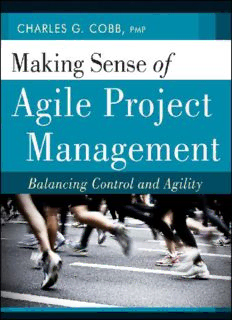
Making Sense of Agile Project Management: Balancing Control and Agility PDF
Preview Making Sense of Agile Project Management: Balancing Control and Agility
Making Sense of Agile Project Management Making Sense of Agile Project Management: Balancing Control and Agility Charles G. Cobb, PMP JOHN WILEY & SONS, INC. Thisbookisprintedonacid-freepaper. Copyright2011by JohnWiley&Sons,Inc.Allrightsreserved Publishedby JohnWiley&Sons,Inc.,Hoboken,New Jersey PublishedsimultaneouslyinCanada Nopart ofthispublicationmay bereproduced,storedina retrievalsystem, ortransmittedinany formor byanymeans, electronic,mechanical, photocopying,recording,scanning,orotherwise, except aspermittedunderSection107or108ofthe1976UnitedStatesCopyrightAct,without eitherthepriorwrittenpermissionofthePublisher,orauthorizationthroughpaymentofthe appropriateper-copyfee totheCopyrightClearanceCenter,222RosewoodDrive,Danvers, MA 01923,(978)750-8400,fax(978)646-8600,orontheweb atwww.copyright.com.Requests tothePublisherforpermissionshouldbeaddressed tothePermissionsDepartment,JohnWiley &Sons,Inc.,111RiverStreet,Hoboken,NJ07030,(201)748-6011,fax (201)748-6008,or onlineat www.wiley.com/go/permissions. LimitofLiability/DisclaimerofWarranty:Whilethepublisherandtheauthorhaveused their besteffortsinpreparingthisbook,theymakenorepresentationsorwarrantieswithrespecttothe accuracy orcompletenessofthecontentsofthisbookand specificallydisclaimanyimplied warrantiesofmerchantabilityor fitnessfora particularpurpose.No warrantymay becreated or extendedbysales representativesorwrittensales materials.Theadviceandstrategiescontained hereinmay notbesuitableforyoursituation.Youshouldconsultwithaprofessionalwhere appropriate.Neitherthepublishernortheauthorshallbeliableforanylossofprofitoranyother commercial damages, includingbutnotlimitedtospecial,incidental,consequential,or other damages. Forgeneral informationaboutourotherproductsandservices, pleasecontactourCustomer CareDepartmentwithintheUnitedStatesat (800)762-2974,outsidetheUnitedStatesat (317)572-3993orfax (317)572-4002. Wileyalso publishesitsbooksinavarietyofelectronicformats.Somecontentthatappearsin printmay notbeavailableinelectronicbooks.For moreinformationaboutWileyproducts,visit ourweb siteat www.wiley.com. LibraryofCongressCataloging-in-PublicationData: Cobb,CharlesG., 1945- Makingsense ofagileprojectmanagement :balancingcontroland agility/ CharlesG.Cobb. p.cm. Includesindex. ISBN978-0-470-94336-6(pbk.);ISBN978-1-118-01568-1(ebk);ISBN978-1-118-01569-8 (ebk);ISBN978-1-118-01570-4(ebk) 1.Softwareengineering.2.Computersoftware–Development–Management.3.Agilesoftware development.I.Title. QA76.758.C572011 005.1–dc22 2010054176 PrintedintheUnitedStatesof America 109 87 65 43 21 Contents Preface ix Who Should Read This Book? ix Brief Overview of the Book x Why I Wrote This Book xii How to Use This Book xiv Part I xiv Part II xv Part III xvi Acknowledgments xvii Part I Overview 1 Introduction 3 Meaning of the Word “Agile” 3 Meaning of the Word “Waterfall” 5 Polarization of Agile and Traditional Waterfall Approaches 7 The Program du Jour Effect 9 Impact on Project Management 10 Common Agile Misconceptions 14 The Pizza Box Methodology 14 All-or-Nothing Thinking 15 Traditional Development Approaches Are Dead 15 Just Do It Faster 16 Becoming Agile Only Impacts the Development Organization 16 Agile Is Just a Development Methodology 17 What Agile Doesn’t Tell You 18 2 Agile Values, Principles, and Practices 21 Lean Software Development Principles 21 Lean Principles 22 Interrelationship of Lean and Agile 36 Agile History and Overview 38 Agile Perceptions and Reality 44 General Agile Practices 47 v vi Contents Organizational Practices 48 Planning Practices 49 Requirements Definition Practices 51 Summary of Agile Techniques and Practices 54 3 Becoming More Agile 57 Agile Benefits and Tradeoffs 57 Focus on Successful Business Outcomes 57 Customer Satisfaction and Competitive Advantage 60 Organizational Effectiveness, Cross-Functional Synergy, and Employee Morale 60 Higher Productivity and Lower Costs 60 Potential for Higher Quality 62 Obstacles to Becoming Agile 62 Corporate Culture 63 Organizational Commitment 66 Risk and Regulatory Environment 66 Developing a More Agile Approach 67 Developing an Agile or Lean Mindset 67 Hybrid Approaches 68 4 Case Studies 71 Sapient 73 Unique Challenges 73 Process Methodology Selection and Design 74 Methodology Summary 77 Methodology Description 78 5 Part I Summary and Action Plan 85 Overall Summary 85 Developing an Action Plan for Your Business 88 Planning Questions 88 Alternative Approaches 91 How Do You Get There? 93 Part II Overview 6 Agile Project Management 101 Agile Project Management Roles 101 Comparison of Traditional and Agile Project Management Roles 103 Agile Business Analyst Role 106 Agile Project Management Approach 107 Project Management Mindset 107 Project Management Skills 111 Contents vii Agile Project Management Practices 112 Agile Project Management Principles 113 Agile Project Management Techniques 117 Agile Project Management Models 119 AgileandAGuidetoProjectManagementBodyofKnowledge (PMBOK Guide) 124 Merging PMBOK Thinking and Agile Thinking 130 7 Fundamental Principles behind SDLC Models 131 General Software Development Life Cycle (SDLC) Considerations 132 Flexibility versus Rigidity 133 Relationship of Training and Process Design 135 Reliable versus Repeatable Processes 136 Interrelationship of Life-Cycle Model Selection Factors 138 Requirements Definition and Management Approach 138 Business Process Considerations 141 Requirements Complexity Considerations 142 Testing Considerations 142 Supportability Considerations 144 Prioritization of Requirements 145 Risk Management, Uncertainty, and Planning Approach 148 Risk Management Considerations 148 Management of Uncertainty Considerations 151 The Role of Planning 154 The Role of Leadership and Training 156 Leadership 156 Training 158 The Role of Documentation 160 8 Software Development Life Cycles 163 Types of Software Development Life Cycles 164 Traditional Plan-Driven Life-Cycle Model 168 Incremental Life-Cycle Model 173 Iterative Plan-Driven Life-Cycle Model 174 Iterative Emergent Life-Cycle Model 176 Adaptive Life-Cycle Model 178 Summary of SDLC Guidelines 180 General Considerations 180 Requirements Management Considerations 181 Risk Management Considerations 181 viii Contents Project Scope and Complexity Considerations 182 Other Considerations 182 Selecting a Software Development Life Cycle 182 Comparison of Approaches 182 Life-Cycle Model Selection Examples 184 9 Part II Summary and Action Plan 191 Summary of Impact on Project Managers and PMI 191 Developing an Action Plan for Project Managers 193 Incremental Improvements 193 Designing and Implementing Hybrid Approaches 194 Implementing Pure Agile Project Management Approaches 194 Helping Companies Move in the Right Direction 195 Part III Appendices Appendix A Overview of Agile Development Practices 199 Extreme Programming 199 Feature-Driven Development 202 Test-Driven Development 205 Pair Programming 207 Code Refactoring 208 Continuous Integration 209 Appendix B Overview of Agile Project Delivery Frameworks 211 Scrum 211 Dynamic Systems Development Model (DSDM) 215 Agile Modeling 219 Agile Unified Process 221 Lean Software Development 224 Additional Reading 228 Glossary of Terms 228 Index 235
Description: